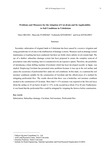Problems and Measures for the Adoption of Cut-drain and Its Applicability to Soil Conditions in Uzbekistan
JIRCAS Working Report
| ISSN | 1341710X |
|---|---|
| 書誌レコードID(総合目録DB) | AA11159468 |

本文フルテキスト
jircas_working_report88-_75-90.pdf715.63 KB
Secondary salinization of irrigated lands in Uzbekistan has been caused by excessive irrigation and rising groundwater levels due to the malfunction of drainage systems. Measures such as drainage system maintenance or leaching has been conducted, but there are fields where salinity levels remain high. The use of a shallow subsurface drainage system has been proposed to ensure the complete removal of percolation water after leaching, but it is considered to be an expensive option. Therefore, the possibility of introducing a drain drilling machine (Cut-drain) which has been developed recently in Japan, was studied. Employing Cut-drain has presented some problems because it rises up to the soil surface and causes the occurrence of preferential flow under dry soil conditions. In this study, we examined the soil moisture conditions suitable for the construction of Cut-drain and the effectiveness of a method for mitigating preferential flow. The results showed that there was a borderline soil moisture condition needed in the construction of Cut-drain. More than 9–11% moisture was required in the first soil layer (from the surface to 20 cm below it) and 12–15%, in the second layer (from 20 to 40 cm). Furthermore, it was found that the preferential flow could be mitigated by irrigating the furrows before construction.
| 刊行年月日 | |
|---|---|
| 作成者 | Yukio OKUDA Haruyuki FUJIMAKI Yoshinobu KITAMURA Iwao KITAGAWA |
| 著者キーワード | Salinization Subsurface drainage Cut-drain Soil moisture Preferential flow |
| 巻 | 88 |
| 開始ページ | 75 |
| 終了ページ | 90 |
| 関連するリソース | 部分である : JIRCAS Working Report no.88 |
| 言語 | eng |
関連する刊行物
部分である
